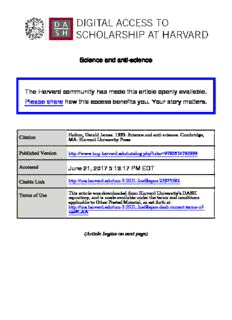
Science and anti-science The Harvard community has made this article openly available. Please ... PDF
Preview Science and anti-science The Harvard community has made this article openly available. Please ...
Science and anti-science Citation Holton, Gerald James. 1993. Science and anti-science. Cambridge, MA: Harvard University Press Published Version http://www.hup.harvard.edu/catalog.php?isbn=9780674792999 Permanent link http://nrs.harvard.edu/urn-3:HUL.InstRepos:23975382 Terms of Use This article was downloaded from Harvard University’s DASH repository, and is made available under the terms and conditions applicable to Other Posted Material, as set forth at http:// nrs.harvard.edu/urn-3:HUL.InstRepos:dash.current.terms-of-use#LAA Share Your Story The Harvard community has made this article openly available. Please share how this access benefits you. Submit a story . Accessibility * < ? ^ ^ 5 6 2 * 6 7 2 6 6 2 7 2 6 4 7 2 2 - 5 6 2 6 7 2 6 6 <2 % ( i GERALD H O L T O N HARVARD U N IV E R S IT Y PRESS Cambridge, Massachusetts London, England 1993 3 Copyright O 1993 by Gerald Holton All rights reserved PRINTED IN THE UUNNIITTEEDD SSTT.ATES OF AM This book is printed on acid-&ee paper, and its binding materials have been chosen for strength and durability. Library of Congress Cataloging in Publication Data Holton, Gerald James. Science and anti-science / Gerald Holton, p. cm. Includes bibliographical references and index. ISBN 0-674-79298-X (alk. paper) 1. Science—Philosophy. 2. Science—History. 1. Title. Q175.H7748 1993 501—dc20 93-272 CIP A 3 To NlNA Contents Preface ix 1. Ernst Mach and the Fortunes of Positivism 1 2. More on Mach and Einstein 56 3. Quanta, Relativity, and Rhetoric 74 4. On the Jeffersonian Research Program 109 5. The Controversy over the End of Science 126 6. The Anti-Science Phenomenon 145 Sources 191 Index 193 Preface What are the earmarks of good science? What goal—if any— looms as the proper end of all scientific activity? What legitimating authority may scientists claim? These old questions, to which each era attempts its own re sponse, are being debated today with renewed vigor. For this book I have selected answers that have emerged mostly in our century and primarily from the words and actions of scientists and scien tist-philosophers. As readers of my previous books would expect, I aim to understand these words and actions not in the abstract, but in the natural setting of specific historic cases. Thus the first chapter traces how the nineteenth-century empir icist view of what good science should be—chiefly the version represented in Ernst Mach's writings—came to influence, often in quite indirect and transmuted form, the thoughts of twentieth- century scientists and philosophers such as Jacques Loeb, B. F. Skinner, Philipp Frank, P. W. Bridgman, W. V. Quine, and some of their colleagues. The chapters that follow deal similarly with controversies and rhetoric that illuminate positions on the proper use, goals, and legitimacy of science, as expressed by such seminal figures as Albert Einstein, Max Planck, and Niels Bohr, but also by less-known ones such as Joseph Petzoldt and Walter Kaufmann. Because it has become clear that the two standard models for the pursuit of research, which generally are traced back to Newton and Bacon, respectively, are no longer adequate to the needs of our time, Chapter 4 is devoted to the rise of a third, additional solution, one that arguably has roots in Thomas Jefferson's approach to sci ence. Increasingly during the last half of this century, voices are heard from various directions that "good science" is inherently an oxy moron, that science as we have known it is ultimately either self destructive (Oswald Spengler's position) or disruptive of the social equilibrium (as, for example, in the passages cited from the IX PREFACE writings of Vaclav Havel). Thus the last two chapters focus on how to understand two confrontations: one is the conflict between the view that the sciences are by their nature subject to eventual decay and the contrary view that the sciences are destined to merge into one coherent body of understanding for all natural phenomena; the other is the more public battle between practitioners of science and opponents who champion "alternative" or anti-science, par ticularly the form that is based in a world picture within which anti science is an organic part of a politically ambitious movement. Here, as throughout the book, there is evident interplay between the interests of scholarship and the turbulent course of public de bate; my hope is that advancing the former provides some clarification for the latter. I gladly acknowledge support for research on portions of this book from the Andrew W. Mellon Foundation, and once more wish to record my gratitude for the expert help of Ms. Joan Laws in all the tasks needed to convert ideas into printed pages. x
Description: